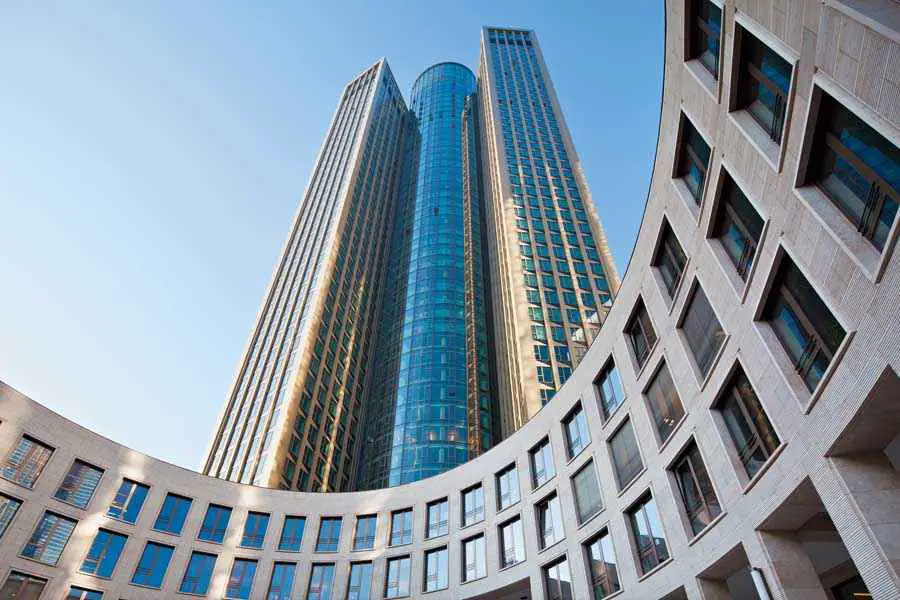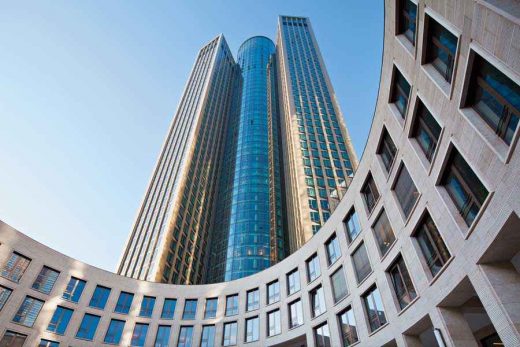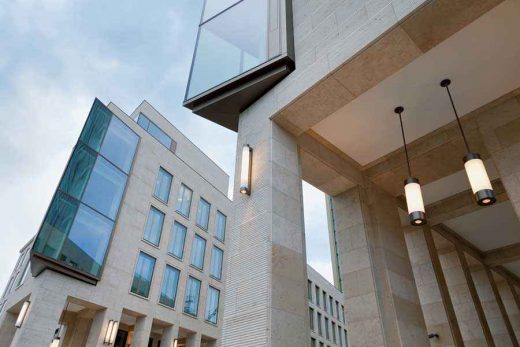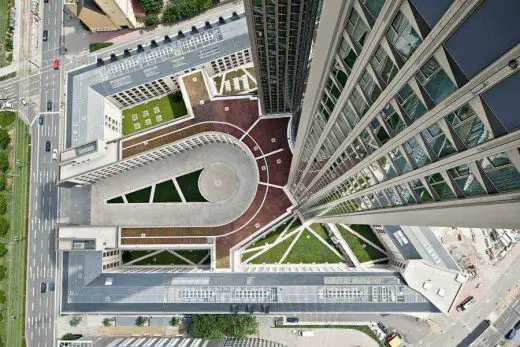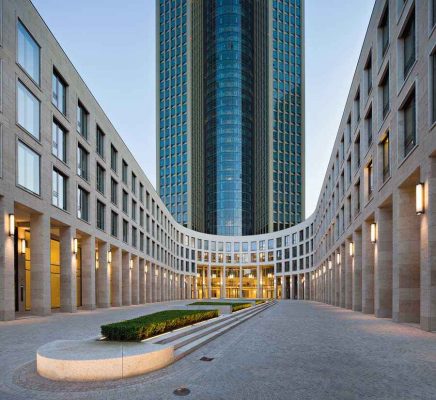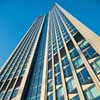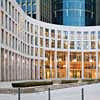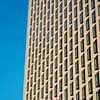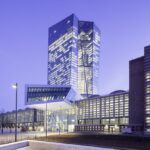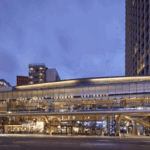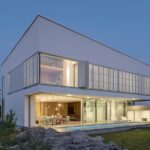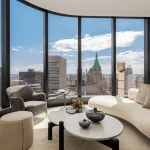Tower 185 Frankfurt, German Skyscraper Building, Office, News
Tower 185 Building : New Frankfurt Skyscraper
Tall Office Development, Hesse, Germany – design by Prof. Christoph Mäckler Architekten
18 Jul 2012
Tower 185 Frankfurt
Frankfurt’s skyline has a new highlight : Tower 185
Design: Prof. Christoph Mäckler Architekten, Frankfurt am Main
Frankfurt am Main, July 2012 – Tower 185 – Germany’s fourth-highest office building – marks the gateway to the new Europa district in Frankfurt am Main and adds a new dimension to the city’s silhouette. The Tower 185 ensemble is made up of two main components: the perimeter block and the tower itself. The style of the perimeter block takes its cue from the urban framework of this European city and forms the layout at street level.
Photos © Klaus Helbig
The levels, materials and colours of the neighbouring buildings – beige stone walls and slate roofs – have been reflected in the new development. It is that and the clear arrangement that enables the development to slot neatly into the streetscape along the Friedrich-Ebert-Anlage boulevard, to merge with the existing to form a new ensemble. This location has thus been given a clear urban identity once again, an identity founded on its history.
The perimeter block facing the road is divided into two halves flanking the opening in front of the tower itself. Splitting the tower into a pair of narrow blocks has resulted in balanced proportions. A curving glass facade links the two narrow blocks, which are set back from the street below and rise out of the perimeter block, opening out towards the city centre. A large teardrop-shaped plaza in front of the tower guides the visitor to the tower’s almost 20 m high entrance lobby. Arcades on all sides with shops and restaurants provide ample opportunity to linger.
An intrinsic design feature of the aluminium-and-glass tower facade is the way it is broken up by lesenes. The bold corner lesenes framing the facade segments accentuate the architecture of the narrow high-rise blocks. Slender lesenes within the area of the facade separate the individual window axes from each other and stretch the facade skywards. Projections and returns between the front edges of the lesenes and the panes of glass create a three-dimensional sculpture of material and light. The black-bronze diagonal sheet metal of the spandrel panels reinforces the relief of the facade and helps to enhance the appearance of the material. As with a finely knitted fabric, the result is an image that leads to ever new, ever more fascinating impressions depending on the sunlight and the weather.
It is primarily the design of the facade plus the type of structural system selected that are responsible for the optimum energy statistics of this form of construction. Reinforced concrete and steel-concrete composite construction have been used for the loadbearing elements. The columns are positioned in the plane of the aluminium-and-glass facade of the tower. Up to 50% of the facade is closed off, shielding much of the interior against direct sunlight. High-performance glazing and the projecting lesenes of the facade shading the areas of glass help to minimise the solar gains. Compared with an all-glass facade, the stone facade to the perimeter block development (Jura travertine from Bavaria’s Altmühl valley, yellow Waldstein granite for the base) and the fenestrated facades of the tower save considerable amounts of cooling energy and reduce the CO2 figures substantially. The energy figures lie more than 20% below those required by German legislation for this type of building.
Besides the fact that energy-savings reduce the running costs, the structural system of central service core plus columns in the plane of the facade add up to another economic benefit: an interior with hardly any columns which can be easily divided into four units. That means maximum flexibility for internal layouts, maximum chances for letting office space.
Türme der Friedrich-Ebert-Anlage – Tower 185, Castor und Pollux, Messeturm und Marriot Hotel:
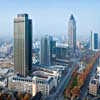
photo © Klaus Helbig
Tower 185 is one of the first office skyscrapers in Europe to be awarded a gold LEED (Leadership in Energy and Environmental Design) certificate by the US Green Building Council; it has also qualified for DGNB (German Sustainable Building Council) silver certification.
There are several important aspects that contribute to the interwoven themes of sustainability, low environmental impact and efficiency. One of those is coil heating and cooling systems which offer optimum heat transfer and the most comfortable environment for users. The advantages of such systems include draught-free air flows, even temperature distribution and low noise levels. User comfort rises while the operating costs fall. All the windows have opening lights so that the mechanical cooling system can be switched off and “natural cooling” used instead.
Tower 185 exploits rainwater, e.g. for watering external planting (100%) and for flushing toilets, and is equipped with water-saving fittings, which results in an annual saving of more than 2.3 million litres of drinking water. Saving resources was even a feature of the construction phase itself. The use of building materials containing recycled material (15–20%), the preference for regional materials (10–20%) and keeping the transport distances short cut CO2 emissions considerably. Choosing paints, coatings and waterproofing materials without hazardous substances was also a key factor. Central waste management during construction led to significant energy-savings. Recycling of construction materials amounted to more than 90%.
Christoph Mäckler founded his own architectural practice in Frankfurt am Main in 1981, which since his appointment as professor at the University of Dortmund in 1998 has been operating under the name of Prof. Christoph Mäckler Architekten. Christoph Mäckler Architekten pursues a policy of integrating structures into their urban context – apt architecture. In doing so, the built environment, made up of private living spaces and public open spaces, is regarded as “urban architecture”.
Christoph Mäckler’s architecture is distinguished by its reconciliation of tradition and modernity. Mäckler seeks to reconnect architecture with its premodern roots. The restoration of surface and volume in the facade and the understanding of the building’s material properties play a pivotal role in his work.
Tower 185 Skyscraper – Building Information
LOCATION: Friedrich-Ebert-Anlage 35-37 60327 Frankfurt am Main
ARCHITECTS: Prof. Christoph Mäckler Architekten, Frankfurt am Main
CLIENT / PROJECT DEVELOPER: CA Immo Deutschland GmbH, Frankfurt am Main (formerly: Vivico Real Estate GmbH)
PROCEDURE: Multiple commission, 1st prize, promoter: Vivico, 2008
PRINCIPAL TENANT: PwC AG
SIZE OF PLOT: approx. 26,000 m2
PLAN AREA OF BUILDING: approx. 13,200 m2
TOTAL LETTABLE SPACE: approx. 100,000 m2
GROSS FLOOR AREA: approx. 129,000 m2
GROSS VOLUME: approx. 500,000 m3
HEIGHT OF TOWER: 200 m
NO. OF FLOORS: 50 (tower), 6 (perimeter block)
NO. OF PARKING SPACES: 551
START ON SITE | COMPLETION: Autumn 2008 | Spring 2012
HOAI PHASES: 1–5, artistic supervision 6–8, tenant fitting-out planning, interior architecture to customer zone, PwC executive suite
PROJECT MANAGEMENT: Christian Schmidt, Soeren Büscher, Ulrike Wess (interior architecture)
PROJECT TEAM: Michael Beckermann, Cornelius Boy, Michael Clanget, Jochen Hettmann, Petra Huber, Boris Kaster, Julian Keetman, Nadine Lorius, Kentaro Matsuno, Julia Nölle, Stephan Schäfer, Udo Schallenkammer, Daniel Schröder, Maik Thätner, Zheng Chen
TOWER 185 / FRANKFURT AM MAIN – PROJECT PARTICIPANTS
CLIENT & PROJECT DEVELOPER: CA Immo Deutschland GmbH, Frankfurt am Main
PRINCIPAL TENANT: PwC AG
ARCHITECTS: Prof. Christoph Mäckler Architekten, Frankfurt am Main
SITE MANAGEMENT: omniCon, Gesellschaft für innovatives Bauen mbH
LANDSCAPING CONSULTANTS: Prof. Christoph Mäckler Architekten with SAL Planungsgruppe GmbH
STRUCTURAL ENGINEERS: RSP Remmel+Sattler, Ingenieurgesellschaft mbH
CHECKING ENGINEERS: Bernhardt Ingenieure GmbH
FIRE SAFETY CONSULTANTS (incl. SITE SUPERVISION) : BPK Brandschutz Planung Klingsch GmbH
FACADE CONSULTANTS (incl. DESIGN) : a+f Architektur u. Fassadenplanung Hans Honig
DESIGN OF LIFTS & CRADLES: Jappsen Ingenieure GmbH
BUILDING PHYSICS: Ebert-Ingenieure Group GmbH & Co. KG / CONSULTANTS: ITA GmbH
LEED CERTIFICATION: Ebert-Consulting Group GmbH & Co. KG, Washington D.C.
LIGHTING CONSULTANTS: Day & Light Lichtplanung GbR
CONTRACTORS
STRUCTURE: Hochtief AG / BSS GmbH consortium
EXCAVATIONS: Züblin Spezieltiefbau GmbH / Weimar GmbH consortium
ALUMINIUM/GLASS FACADE: FKN Fassaden GmbH & Co. KG
STONE FACADE: Hofmann GmbH & Co. KG
LIFTS: KONE GmbH (lifts & escalators)
Tower 185 Frankfurt image / information from Prof. Christoph Mäckler Architekten, Frankfurt am Main
Prof. Christoph Mäckler Architekten
Location: Friedrich-Ebert-Anlage 35–37, 60327 Frankfurt am Main, Germany
Frankfurt Buildings
Contemporary Frankfurt Architectural Projects
Frankfurt Architecture Walking Tours by e-architect
Frankfurt Skyscrapers
KfW-building : “Best Tall Building in the World 2011”
sauerbruch hutton
KfW Westarkade Building
Commerzbank Tower
Foster & Partners Architects
Commerzbank Tower Frankfurt : 259m high
Frankfurt Architecture Walking Tours
Comments / photos for the Tower 185 Frankfurt page welcome

